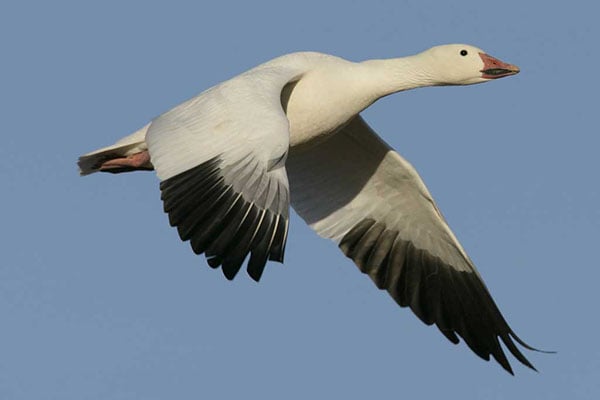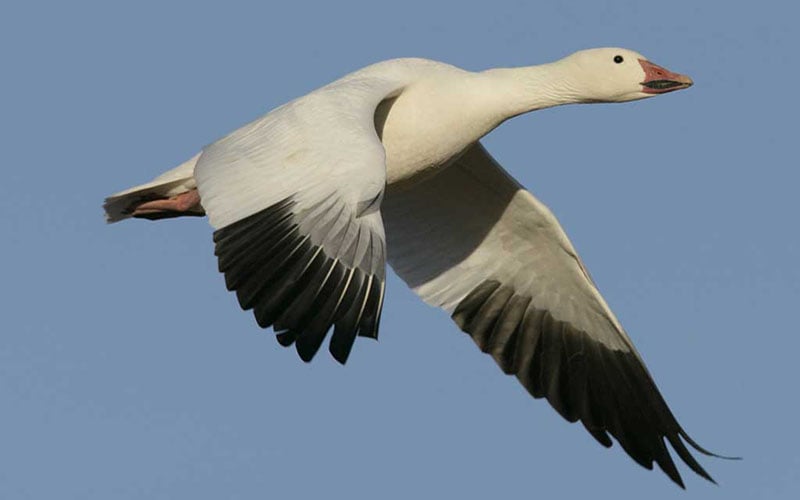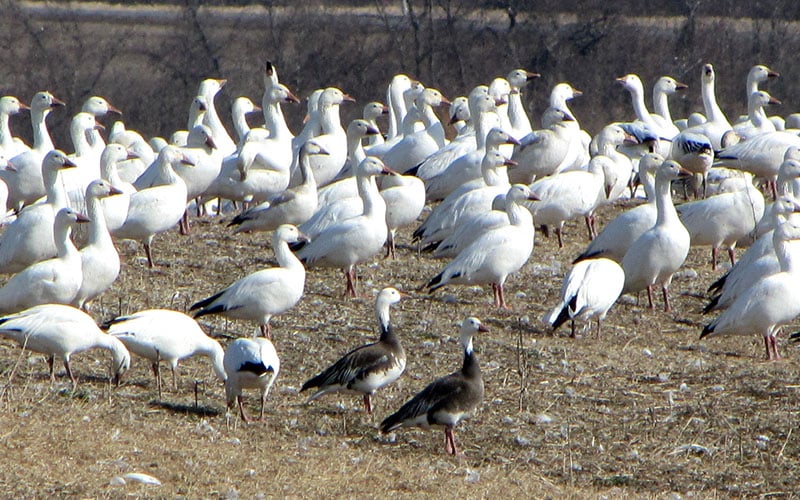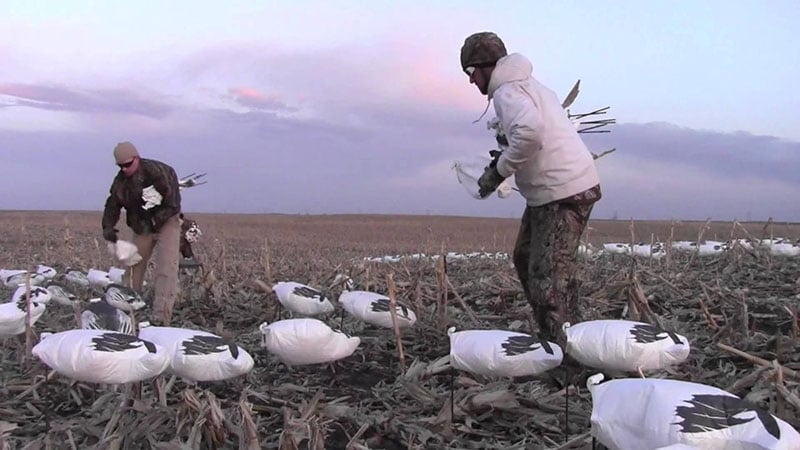
Last Updated on
Traveling in flocks of several thousand or more, Snow Geese can create some of the most exciting and awe-inspiring hunting experiences in the world. Successfully hunting them however, can be almost impossible without the right knowledge and strategy.
There is nothing quite like watching a massive flock of Snow Geese spiral down from high in the sky. The birds can create an amazing snow globe effect as they descend with an outcry of powerful honking sounds.
The loud and rowdy Snow Goose can cover a field with a white blanket during certain times of the year. Since the 1950s-1970s, Snow Geese populations have exploded, and the strict hunting regulations of the past are, for the most part, long gone.
Greater Snow Geese
While it can be almost impossible to tell them apart, there are two primary subspecies of the Snow Goose. The Greater Snow Goose is slightly larger than the Lesser Snow Goose and, upon close inspection, it can also be identified by its larger bill. Both sexes are almost identical in appearance, but females tend to be a little smaller. These geese are known for their solid snow-white bodies, black wingtips and long, thick necks.
The primary breeding grounds of the Greater Snow Goose range from Foxe Basin to northern Baffin, Bylot, the Ellesmere Islands and Greenland. They nest in colonies typically along well-drained westward slopes and well-vegetated hilltops. Females lay approximately four eggs.
When the time comes for the fall migration, Greater Snow Geese abandon the artic breeding grounds and travel through a narrow corridor in eastern Canada and the northeastern US to the Atlantic Coast. They winter primarily on the coasts from New Jersey to North Carolina.
The Greater Snow Goose is a “grubber” when it comes to feeding. They look for roots, bulrush shoots, cordgrass shoots and rhizomes. During the winter, they take full advantage of any nearby agricultural fields.
Lesser Snow Geese
Unlike the Greater Snow Goose which has only one color phase, the Lesser Snow Goose has a dark-blue phase and a snow-white phase. These two colorations are simply variations within the same species. Birds in the dark phase still have white necks and heads, but with bluish-gray body. In the white phase, they look just like their Greater cousins with solid snow-white bodies and black wing tips.
Both phases have pinkish bills, legs and feet. In some cases, the minerals in the soils where they feed may stain their heads a rusty-brown. In general, Lesser Snow Geese are highly vocal and can be heard from distances greater than a mile away.
Lesser Snow Goose breeding grounds stretch from the Queen Maud Gulf, Victoria Island, Banks Island and Baffin Islands to the Hudson Bay. The choose nesting areas on low-lying grassy plains, shallow coastal river banks and the islands of inland lakes with shallow water. Lesser Snow Geese nest in large colonies, and females lay, on average, four or five eggs.
Historically, Lesser Snow Geese migrated along the Pacific and Mississippi flyways to wintering grounds in California’s Central Valley and the Gulf Coast of Mexico, Texas and Louisiana. These areas have provided years of the abundant emergent vegetation needed for food and cover. In recent decades, Lesser Snow Geese have expanded their wintering grounds to the interior agricultural areas of Mississippi, Arkansas, Texas and Louisiana where pasture grasses, rice and corn offer plentiful food supplies.
General Snow Goose Facts and Characteristics
Snow Geese have an almost overwhelming appetite for grasses, shrubs, sedges, forbs, rushes, horsetails and willows. They can consume almost every part of a plant from the roots and tubers to the seeds, leaves and stems. During winter and their migration, they also go for berries, grains and immature farm crops.
Although they spend most of their time resting or feeding, Snow Geese are very strong flyers, swimmers and walkers. They can move very quickly in the air and surprisingly fast along the ground. Even within the first few weeks of hatching, some gosling may follow their parents on foot for up to 50 miles. When threatened, Snow Geese can even dive under the surface for short distances. During the breeding season, they often rest in the nesting areas on ground, but during winter and migration, they tend to sleep while afloat to avoid predation.
Gear and Equipment for Snow Geese
Experienced hunters will tell you that your hunting gear is one of the most important factors for success when going after Snow Geese. Out of all the essential gear, decoys are typically the most expensive. Snow Geese, especially late in the season, look for extremely large colonies of other geese feeding. Unfortunately, that means you need a very large decoy spread. Most experts recommend 1,000 decoys or more, but you should have at least 500.
You should never have too many of the same decoys in your spread either. You should vary between different sizes and types, but most importantly, you should makes sure you have some movement with flying decoys and wind socks throughout. White plastic bags and rags can be used to fill out your spread for cheap.
While Snow Geese are well known for moving in large flocks, they are also very vocal birds. Snow Goose calls are key to bringing experienced birds in close on approach. There are three common types of goose calls to consider: short-reed, flute and resonant-cavity. All three have strengths and weaknesses. You should also take a look at some calls specifically designed for Snow Geese.
As with any goose hunting, choke tubes are essential for providing the kill shot at appropriate distances. Most experienced hunters recommend improved cylinder and modified chokes, but some like to use even tighter chokes to bring birds down from farther away. Although Snow Geese are not quite as large as Canada Geese, most hunters still use 3” shells and up with BB shot or heavier when hunting these birds.
Quick Snow Geese Hunting Tips
When compared to other game birds, Snow Geese are very fast learners and grow extremely wary during hunting season. Their large flocks also allow them to have countless eyes to examine potential landing areas before close approach. Hunting these birds requires a lot of strategy and hard work, but hopefully these quick tips will increase your chances of success the next time you hit the fields.
Scouting is as important for Snow Goose hunting as it is with any other game animal. Start early by searching back roads for fields where Snow Geese like to feed. Once you’ve found a good place, ask the landowner for permission and get those decoys set. If you can complete you decoy spread by mid-afternoon, you can probably hunt later that evening and the following morning.
Although Snow Geese naturally return to any field until the food resources are gone, they don’t like to return to a place where they’ve been hunted recently. Once you’ve found a great field, you may have 1-2 days of amazing hunting, but after that, they will be gone and it will back to scouting.
Camouflage and stealth are very important when hunting Snow Geese. The birds will pick up on anything unnatural near the spread, especially during the late season. You need to keep your vehicles at least 800-1000 yards away, and make sure all tire tracks and other signs of human activity are hidden. Good camouflage clothing that matches the field is essential, including white camo for snow-covered fields.
In the end, Snow Geese simply require a more intense style of hunting than other game animals. It takes a lot of time, skill and money to really get into Snow Goose hunting. However, if you ask anyone who has ever watched a vortex of thousands of Snow Geese descending on top of them, they will tell you that it is absolutely worth it!








Leave a Reply